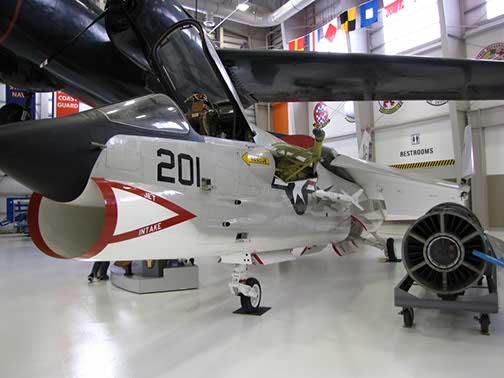NAS Pensacola
Nine photos from the Naval Air Station museum in Pensacola, Florida.
F-8A
Accepted by the U.S. Navy on 20 June 1958, the museum's F-8A (F8U-1 until 1962) spent much of its early service career at Naval Air Station (NAS) Cecil Field, Florida, assigned to Fighter Squadron (VF) 174 for more than two years training East Coast Crusader replacement pilots. In November 1960 it joined VF-11, its first and only front line fighter squadron. While flying with the famed "Red Rippers," the aircraft was part of an unusual deployment in the carrier Franklin D. Roosevelt (CVA 42). Though VF-11 sailed with the carrier from Naval Station Mayport, Florida, on 15 February 1961, the squadron spent most of FDR's cruise shore based at the U.S. naval base at Rota, Spain. There the squadron averaged around 600 flight hours per month while practicing tactics and gunnery and occasionally firing Sidewinder missiles. VF-11 also engaged Air Force F-104s from a nearby base in mock dogfights.
Returning to Cecil Field with VF-11 on board FDR in August 1961, the aircraft remained with the squadron until April 1962, at which time it rejoined VF-174. In the summer of 1963, it was reassigned to Utility Squadron (VU) 2 at NAS Oceana, Virginia, remaining with this squadron, which assisted the Anti-Air Warfare Training Center at Dam Neck, Virginia, until June 1964. During its service with VU-2, the aircraft deployed to San Juan, Puerto Rico.
Following a period of storage at Naval Air Facility (NAF) Litchfield Park, Arizona, the aircraft was sent to Naval Air Rework Facility (NARF) North Island, California, in April 1966. Three months later, it moved to NPRO (U.S. Navy Plant Representative Office) in Baltimore, Maryland, where it was destined to remain until March 1971.
At that time, the Naval Aviation Museum received a telephone call from the Office of the Chief of Naval Operations informing the command that an F-8A was available for assignment to Pensacola. On 11 March 1971, the museum accepted the offer. Four days later, having flown to NAS Pensacola, the aircraft was stricken from the Navy inventory and turned over to the Naval Aviation Museum. It was repainted in the markings of VF-24 at the Naval Aviation Depot (NADEP) Pensacola during 1987.
Notes In September 1952 the Navy issued specifications for a new carrier-based fighter which, aside from normal requirements for easy maintenance, folding wings and a slow landing speed, also called for the capability to exceed the speed of sound in routine level flight.
Though it was the competitor considered least likely to succeed as a result of producing three earlier disappointing fighters for the Navy (F5U, F6U Pirate, and F7U Cutlass), Chance-Vought won the bid over seven other manufacturers. Its design was the F8U (later redesignated F-8) Crusader and it became one of the most capable fighters of the post-World War II era, a sleek design that featured a gaping jet intake beneath the fuselage and variable-incidence wing that could be raised. With the aircraft's cockpit located far forward on the fuselage, the wing correspondingly lowered the angle of incidence to provide the pilot better visibility when approaching the carrier deck or runway. It also allowed the aircraft to land and take off at slow speeds.
In an era in which fighter pilots relied increasingly on missiles, the Crusader retained 20mm cannon, prompting its pilots to call it the "Last of the Gunfighters." The F-8 made history almost immediately. Commander Robert W. Windsor established a national speed record on 21 August 1956, reaching 1,015.428 M.P.H. over a 15-kilometer course. In so doing, the F-8 became the first operationally equipped jet aircraft to fly faster that 1,000 M.P.H. On 16 July 1957 future astronaut Major John H. Glenn, Jr., USMC, flew a photo reconnaissance version of the aircraft in a record transcontinental flight, taking off from Los Alamitos, California, and reaching Floyd Bennett Field, New York, in 3 hours, 22 minutes, and 50.05 seconds.
Crusaders flew their first combat missions triggering cameras instead of weapons as part of the photo reconnaissance flights over Cuba during the Cuban Missile Crisis in October 1962. F-8s also logged these missions as well as strike and combat air patrol flights throughout the Vietnam War, with Crusader pilots credited with shooting down eighteen enemy MiGs in aerial combat.
The RF-8A photo reconnaissance aircraft were the last U.S. Navy Crusaders in the air and were retired from the Naval Air Reserve in 1987. However, the French Navy operated the type until 1999.
Specifications
Manufacturer: LTV Aerospace Corporation
Dimensions: Length: 54 ft., 3 in.; Height: 15 ft., 9 in.; Wingspan: 35 ft.; 8 in.
Weights: Empty: 17,836 lb.; Gross: 34,100 lb.
Power Plant: One 18,000 lb. static thrust with reheat Pratt & Whitney J57-P-20 turbojet
Performance: Maximum Speed: 1,133 M.P.H. at 35,000 ft.; Service ceiling: 52,350 ft.; Range: 1,425 miles
Armament: Four fixed forward-firing 20mm cannon, four AIM-9 Sidewinder missiles and up to 5,000 lb. of ordnance
Crew: Pilot
Aircraft in the Museum Collection
F-8A (BuNo 145347)- On indoor static display
F-8A (BuNo 141351)- On loan to NAS Jacksonville, Florida
F-8A (BuNo 143806)- On loan to Delaware Valley Historical Aircraft Association
F-8A (BuNo 145397)- On loan to NAES Lakehurst, New Jersey
